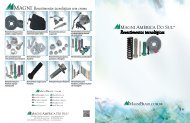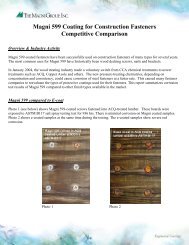Magni Wind Power Article... - The Magni Group, Inc.
Magni Wind Power Article... - The Magni Group, Inc.
Magni Wind Power Article... - The Magni Group, Inc.
- TAGS
- magni
- themagnigroup.com
Create successful ePaper yourself
Turn your PDF publications into a flip-book with our unique Google optimized e-Paper software.
FASTENING, JOINING, & BOLTING<br />
Choosing the right coating for fasteners<br />
T<br />
he importance of fastener coatings is<br />
becoming more apparent throughout<br />
the wind industry. Different coating<br />
chemistries have been used to improve<br />
corrosion protection, or lubricity, or both.<br />
However, increasing demands on field life, global<br />
legislation, and worldwide commonization<br />
continue to create challenges for many<br />
traditional coatings.<br />
A thorough understanding of a fastener’s<br />
coating performance can ensure joint integrity,<br />
as well as improve field life and serviceability.<br />
Global acceptance and availability are also key<br />
considerations in choosing the right coating.<br />
Advantages of fastener coatings<br />
<strong>The</strong> importance of corrosion protection and<br />
lubricity in the wind industry differs from<br />
the building trades or the appliance industry. Varying<br />
demands have made it impossible to formulate one<br />
universal coating. A short list of what a coating should do<br />
includes:<br />
• Improve appearance<br />
• Add lubricity<br />
• Protect against corrosion<br />
Appearance<br />
This is of lesser concern in most turbine joints, but it<br />
plays a key role when choosing a fastener coating in the<br />
building trades and appliance industry. Electroplated<br />
and electrocoated fasteners are predominant in these<br />
industries. Because such fasteners are often visible,<br />
it is essential to match colors and coat uniformly.<br />
Electroplated fasteners offer good uniformity and come<br />
in several different colors using different passivation<br />
systems, dyes, and a topcoat. Electrocoated fasteners<br />
also offer good uniformity but are typically available only<br />
in black.<br />
16 WInDPoWEr EnGInEErInG & DEVELoPmEnT APrIL 2012 www.windpowerengineering.com<br />
Edward Koneczny<br />
<strong>Wind</strong>power market manager<br />
<strong>The</strong> magni <strong>Group</strong>, <strong>Inc</strong><br />
www.themagnigroup.com<br />
<strong>The</strong> <strong>Magni</strong> 565 coating allows formulating lubricants into the topcoat,<br />
usually eliminating the need for messy post-treatments. This<br />
non-electrolytically applied, zinc-and-aluminum-rich coating also<br />
eliminates concern of hydrogen embrittlement. <strong>The</strong> coating can be<br />
formulated in many colors. It also comes in several friction levels<br />
while providing good consistency across many bearing surfaces.<br />
Lubricity<br />
Identifying a coating with the right frictional characteristics is<br />
probably the most crucial task. Erratic friction during assembly leads<br />
to either a loose joint or too much strain on the fastener. Either<br />
event can lead to a failed joint.<br />
Two important components of lubricity are consistency and<br />
efficiency. Both are required to insure joint integrity and easy<br />
assembly. Proper lubricity assists the fasteners’ ability to efficiently<br />
reach its designed load at a prescribed torque. <strong>The</strong> torque-tension<br />
graphs (next page) demonstrate how properly integrated lubrication<br />
can improve joint consistency.<br />
Some alloy platings also have improved lubricity but are typically<br />
more expensive than zinc plate or dip and spin coatings.
Input torque versus clamp force<br />
for a Zinc+ lubricant-coated bolt<br />
Zinc-coated bolts show high deviation in the torque required to<br />
get several to a 30,000-n clamp load.<br />
Corrosion protection<br />
<strong>The</strong> harsh environments of wind farms<br />
have significantly increased demands<br />
on corrosion protection. <strong>The</strong> increasing<br />
demand on field life, as well as the use<br />
of aluminum and magnesium in other<br />
assemblies, emphasizes the importance<br />
of high-performance fastener finishes.<br />
Bimetallic assemblies often rely on<br />
coatings to reduce galvanic potential or<br />
insulate different materials in an effort<br />
to minimize corrosion rates. For this<br />
purpose, a duplex coating is becoming<br />
more prevalent.<br />
500 hours NSS, 1000 hours NSS<br />
<strong>The</strong> three bolts on the left have been<br />
hot-dipped galvanized (HDG) and subjected<br />
to ASTm B117 for 500 hours. <strong>The</strong><br />
three on the right, coated with magni<br />
565, have endured the same test but for<br />
1,000 hours.<br />
Mechanics of corrosion protection<br />
Although there is a myriad of finishes to<br />
choose from, there are only two basic<br />
types of corrosion protection: Barrier<br />
protection and sacrificial protection<br />
Both protect the substrate from<br />
corrosion, but do so in distinctly different<br />
ways. To better explain these methods of<br />
protection, it is first important to review<br />
the corrosion mechanism. Iron corrodes<br />
by anodic, cathodic, and diffusion<br />
reactions. <strong>The</strong> reactions are described<br />
as:<br />
Anodic reaction<br />
Fe → Fe 2+ + 2 e-<br />
Cathodic reaction<br />
4 e- + 2H 2o + o 2 → 4(oH - )<br />
Diffusion reaction<br />
2Fe 2+ + 4(oH - ) → 2Fe(oH) 2<br />
Fe(oH) 2 + o 2 + H 2o → Fe 2o3 + H 2o<br />
Corrosion prevention inhibits the rate of<br />
these reactions, with either a barrier or<br />
sacrificial coating to the substrate.<br />
Input torque versus clamp force<br />
for <strong>Magni</strong> 565-coated bolts<br />
<strong>Magni</strong> 565 coated bolts provide better uniformity in the torque<br />
needed to produces a 30,000-n clamp load.<br />
Barrier protection<br />
one way to protect ferrous substrates<br />
is with a barrier coating. Here, the<br />
coating works as a barrier between a<br />
corrosive media and the substrate. Such<br />
coatings, often organic and polymeric<br />
in nature, come in a wide array of colors<br />
and can be applied many different<br />
ways, including by electrophoresis<br />
(electrocoat). <strong>The</strong>se can be extremely<br />
effective, but performance diminishes if<br />
the barrier (coating) is damaged during<br />
assembly. <strong>The</strong>se defects, macroscopic<br />
and microscopic, are inevitable and give<br />
the environment access to the substrate.<br />
once this happens, oxidation of iron,<br />
along with the cathodic reduction of<br />
dissolved oxygen, attributes to the<br />
generation of oH¯ (alkalinity). Generated<br />
alkalinity can react with the coating<br />
causing it to dis-bond or delaminate<br />
from the metal interface, ultimately<br />
causing coating failures.<br />
Barrier protection works best when<br />
coating defects are kept to a minimum.<br />
Excessive coating damage diminishes<br />
the corrosion protection proportionally<br />
and leads to premature failures.<br />
<strong>The</strong>refore, material handling is critical<br />
when this technology is used.<br />
www.windpowerengineering.com APrIL 2012 WInDPoWEr EnGInEErInG & DEVELoPmEnT 17
F A S T E N I N G , J O I N I N G , & B O L T I N G<br />
Sacrificial protection<br />
Another corrosion protection option<br />
applies a sacrificial coating. <strong>The</strong>se<br />
include electroplating-galvanizing,<br />
Hot Dip Galvanizing (HDG), along with<br />
inorganic-organic duplex coatings.<br />
Although the application method for<br />
sacrificial coatings can vary significantly,<br />
the protection mechanism is similar.<br />
Sacrificial corrosion occurs when<br />
two dissimilar metals come in contact.<br />
<strong>The</strong> more active of the two metals in<br />
the cell becomes a sacrificial anode<br />
and cathodically protects the other. To<br />
protect steel fasteners from corrosion,<br />
they are often coated with metals of<br />
higher reactivity. Zinc-rich coatings,<br />
whether electroplated, galvanized,<br />
or non-electrolytically applied, offer<br />
cathodic protection for steel fasteners<br />
by letting the coating “sacrifice” itself<br />
in place of the ferrous fastener. This<br />
technology relies on the coating to<br />
preferentially corrode.<br />
Sacrificial coatings are affected less<br />
by coating defects than barrier coatings.<br />
<strong>The</strong> coating, which contains a more<br />
reactive metal, still provides cathodic<br />
protection around small voids and<br />
defects. However, excessive material<br />
handling can diminish the performance<br />
of this technology as well.<br />
Understanding how these two<br />
systems provide corrosion protection<br />
makes it clear why duplex systems,<br />
such as magni 565, can offer high<br />
performance to conventional<br />
galvanizing. <strong>The</strong> topcoat’s resistance of<br />
a corrosive media’s coming in contact<br />
with a sacrificial coating delays the<br />
18 WInDPoWEr EnGInEErInG & DEVELoPmEnT APrIL 2012 www.windpowerengineering.com<br />
corrosion mechanism. In addition, these<br />
topcoats can be formulated to provide<br />
specific frictional characteristics. WPE<br />
Discuss This<br />
and other <strong>Wind</strong> issues at<br />
www.engineeringexchange.com<br />
Share this online<br />
Email, Post, or Share on your<br />
favorite social network





